Check Engine Light Flashing But No Codes: 4 Causes + How To Fix?
When the engine light flashes but no code shows up, that’s a sign of an intermittent engine misfire issue that comes and goes. With this type of intermittent misfire, start by methodically checking a few key parts – fuel injectors to make sure they’re clean and working properly, the ignition coil pack for any damage since this part creates the spark for combustion, and inspecting each spark plug for buildup, burning, oil or damage. Good spark plugs are needed for proper ignition, so replace any bad plugs that could be causing the misfire.
Your check engine light is flashing and your vehicle has started shaking with intermittent rough idling. Moreover, some of you might have observed that the blinking check engine light went away for a few miles and then started flashing again. In this guide, I’ll cover all possible reasons that cause this situation to happen. I’ve also highlighted diagnostic methods for different possible causes so that you can pinpoint the root cause easily.
If you prefer a brief overview instead of reading the entire article, here is a summary table to quickly gather the information:
| Causes | Descriptions |
|---|---|
| Bad ignition coils, distributor caps, or coil packs | Failed ignition coils or coil packs can cause engine misfire and flashing check engine light. Check for damage, cracks, moisture. |
| Spark plug not seated or damaged | Incorrect spark plug torque, gap, fouling, or physical damage can prevent proper sparking. |
| Damaged fuel injectors | Faulty fuel injectors can inject too much or too little fuel, disrupting air-fuel ratio and causing misfires. |
| Intermittent check engine light | Trouble codes may be clearing before they can be read. Pending/history codes may provide clues. |
Causes Of Check Engine Flashing But No Codes
Here are some of the most common causes of check engine light flashing but no codes.
1. Check Engine Light Is Flashing Intermittently
If your car is giving a flashing check engine light at times, the chance is that your vehicle’s computer had set the code but when the flashing check engine light went away and the code was cleared. Due to that, your OBD2 scan tool couldn’t detect the trouble code.
There can also be pending trouble codes, which means the computer has detected a problem but has not yet reached the threshold to illuminate the check engine light continuously. A pending trouble code during a flashing check engine light can also mean that a random misfire may occur typically less than three times.
Some old scanners can’t detect any pending trouble codes or those diagnostic trouble codes that are stored in the history.
I found the OBD2 scan tool by BlueDriver quite functional as it reads confirmed trouble codes, history trouble codes, and pending trouble codes.
History trouble code means that a vehicle experienced a serious intermittent misfire that threw a trouble code, but the misfire is not currently occurring.
As an example, if you hit a bump while driving, it could cause a spark plug to move or a wire to wiggle the wrong way and prevent the spark plug from getting a great connection.
As a result, a misfire would occur for a few seconds which would cause a pending trouble code. At this point, a flashing check engine light might occur for some time then it goes away.
How to diagnose?
Now, if you’re using a Bluedriver OBD2 scan tool to detect trouble codes that are causing a flashing check engine light, it will show pending/history trouble codes or confirmed trouble codes as I have shown in the picture below:
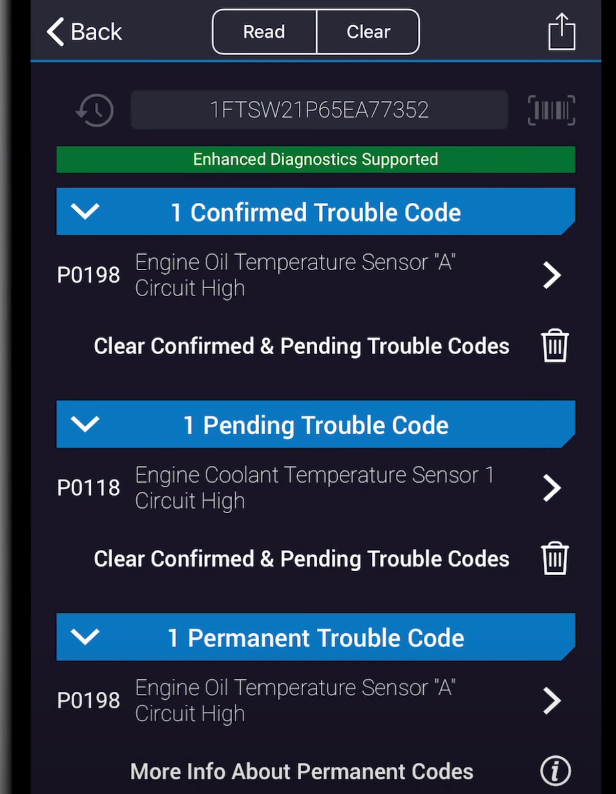
If the OBD2 reader still does not show a trouble code, you can try driving with the OBD scanner attached.
Usually, we scan the code by only turning on the ignition key and keeping the engine off.
But, if the check engine light is flashing without any codes, I would suggest you start the engine and continue driving with the OBD2 code attached.
This is because you need a certain amount of engine misfires in a drive cycle to set a trouble code.
You can also check fuel pressure while keeping the engine ‘ON’ using a live data option on the BlueDriver OBD2 reader.
Depending on the engine, the suitable fuel pressure is between 40 and 60 psi. If the fuel pressure is out of range, it can be a sign of a bad fuel pressure regulator.
2. Bad Ignition Coils, Distributor Caps or Coil Packs
If an ignition coil or coil pack fails, it will cause the engine to misfire. The engine management system will detect the misfire and trigger the check engine light.
The check engine light will flash if the misfire is severe enough to cause damage to the catalytic converter.
The ignition coil or coil pack is an important part of your engine’s electrical system. It’s like a transformer that steps up the low voltage from your battery to the high voltage needed to fire your spark plugs.
Inside an ignition coil are two sets of windings. The primary windings are made of thick wire and have relatively few turns. The secondary windings are made of thinner wire and have many more turns.
The low voltage from your battery is applied to the primary windings. This creates a magnetic field. When the current is suddenly interrupted (by the ignition switch), the magnetic field collapses. This collapse induces a high voltage in the secondary windings. This high voltage is sent to the spark plugs, where it jumps across the spark plug’s gap and causes the spark that ignites the air/fuel mixture in the engine.
In engines, there are three types of configurations of ignition coils:
- Coil on plug (COP)
- Distributor
- Coil pack
In my guide on the check engine light flashing and car shaking, you can learn about the configurations of the ignition coil.
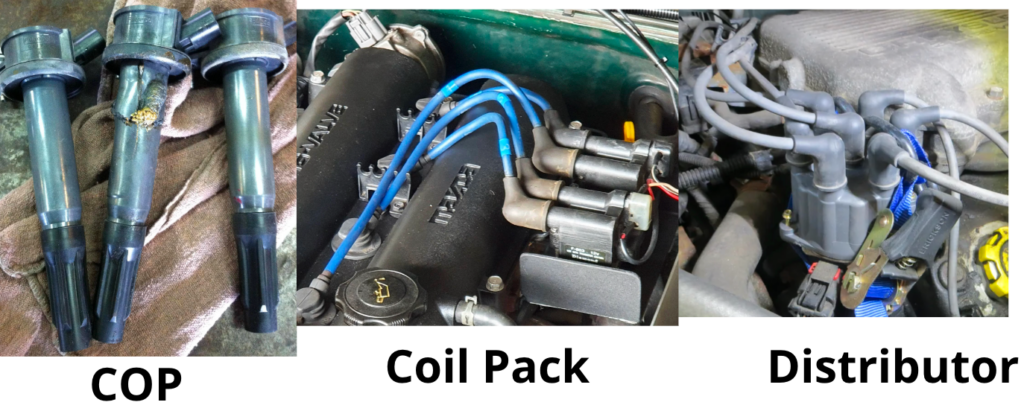
Coil on plug configuration is in modern engines. In this configuration, each spark plug has an ignition coil.
How to diagnose?
There can be a hairline crack around the neck of COP where the spark plug inserts into the ignition coil. The fuel can leak from there and cause a misfire in that cylinder where the ignition coil is damaged.
If your vehicle has an ignition coil pack instead of COPs, you should check the insulation of each wire that leads from the coil pack to the spark plugs. There should not be cuts or bends.
Note: You may also swap ignition coils one by one and find which ignition coil is the cause of an engine misfire.
In Chevys and some older vehicles, distributors are used. A distributor has one ignition coil that distributes voltage to each spark plug through the distributor cap.
A distributor helps to ensure that the spark plugs fire in the correct order, and at the correct time. So, a bad distributor can also cause engine misfires.
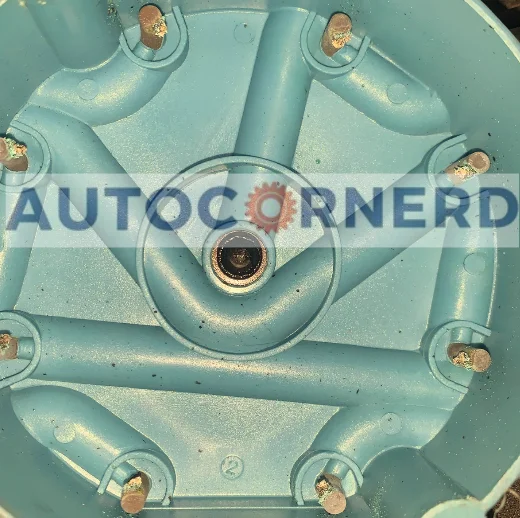
Note: It is also a good idea to check the connector that is plugged into the ignition coil. The intermittent illumination of a flashing check engine light without codes might be due to a damaged connector of the ignition coil. You should check its insulation and make sure there is no moisture inside the connector.
3. Spark Plug Is Not Properly Seated Or Damaged
If the spark plugs are not seated right and tightened enough, the fuel/gas will leak through the engine cylinder.
Because of this, the ratio of the fuel in the air-fuel mix is upset. This will make the engine misfire and the check engine light flash. In the owner’s book of the car, the tightening need for a spark plug is talked about.
For example, the tightening need for the spark plug in a Toyota Yaris is 27 N.m.
You should be careful when working with a spark plug wrench. Its skewing can cause damage to the threaded connection of the spark plug. Moreover, if you exceed the tightening torque requirement of the spark plug, it will damage the thread connection.
You should also check the condition of the spark plugs. A spark plug can get fouled with oil, dirt, and other stuff, and this can make it stop working right.
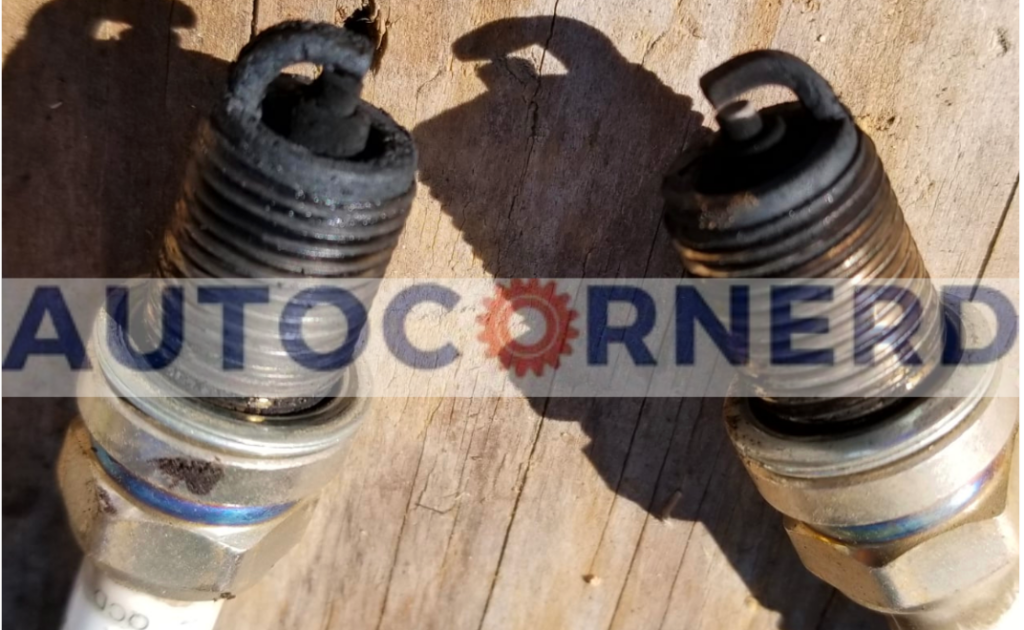
Another common reason for spark plugs to go bad is that they are not right gapped.
The gap is the space between the electrode and the metal tip of the spark plug, and it is important that this gap is set right.
If the gap is too big, the spark will not be able to jump the gap, and the engine will not turn over.
You should also check the protected part of the spark plug. If it has signs of cracks, it means the spark plug is bad.
This PDF is quite helpful to understand the signs of a bad spark plug.
Moreover, BlueDriver company has also uploaded a very helpful video on its YouTube channel to diagnose engine misfires and fix a flashing check engine light.
4. Damaged Fuel Injectors
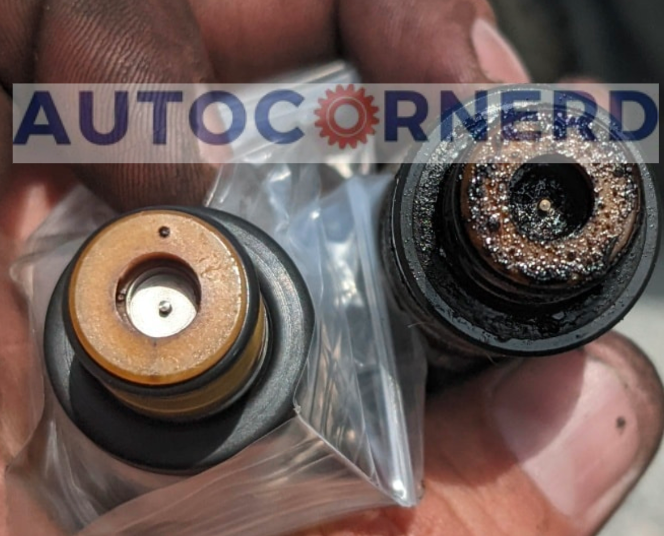
If the fuel injector is any of the engine cylinders is damaged, it will also cause engine misfires and flashing check engine light. Fuel injector is just like a control solenoid valve that is electronically controlled by the ECU (Engine Control Unit).
If the fuel injector injects too much fuel, it will foul the spark plugs and cause engine misfires. In my guide on car won’t start after replacing fuel injectors, I have explained how to test fuel injectors.
Like the ignition coil, also inspect each connector of the fuel injector. Check if the insulation of the connector cable is broken at some point.
The following Youtube video is quite helpful:
Final Thoughts
In summary, a flashing check engine light without codes usually means the engine sometimes misses firing. This is called an intermittent misfire.
The most common causes are:
- Bad ignition coils or coil packs
- Damaged spark plugs
- Faulty fuel injectors
You need to inspect and test these engine parts to find the problem. Replacing damaged parts and setting spark plug gaps right should fix it.
Some First Hand Experiences Shared By Users In Different Communities
Our team conducted research across various online communities, forums, and subreddits to gather user comments and opinions on “check engine light flashing with no error codes”.
User 1 says:
In my 2008 Clio, the check engine light was flashing, but my OBD reader showed nothing. I noticed the car was idling rough. After some digging, I found out it was a failing ignition coil. Replaced it, and the light went off.
User 2 says:
Faced this on my 2013 Fiat 500. The check engine light was flashing but no codes showed up on the scanner. Eventually, I found out it was due to a bad fuel injector. Replaced it and the issue was resolved.
User 3 says:
My 2014 CX-5 had a flashing check engine light, no codes. I noticed a decrease in fuel efficiency. The culprit was a dirty mass airflow sensor. Cleaned it, and the issue disappeared.
User 4 says:
Had the check engine light flashing on my 2011 C300, but no codes were showing. After a bit of research, I realized it was due to a faulty crankshaft position sensor. Replacing it solved the issue.
How did you fix your flashing check engine light issue without any trouble codes? Please vote.
[yop_poll id=”21″]
